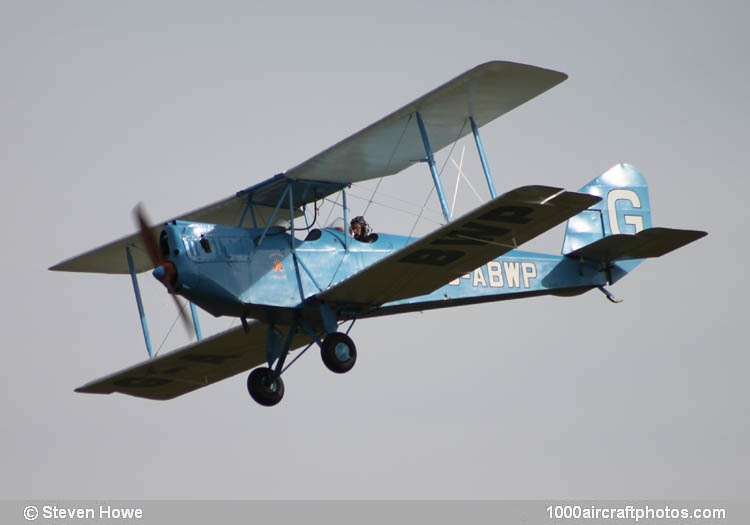Although a non-symmetrical wing section was employed, much of the original interchangeability was ingeniously retained by a system of detachable wing tips and trailing edge sections which enabled a wing to be fitted on either side and the aileron at either end. The two halves of the landing gear were still interchangeable, but the vertical tail surfaces were of entirely new outline. The Arrow was otherwise structurally orthodox, with spruce and plywood fuselage and wooden, fabric covered, folding wings, but the cockpits, entered via large doors, were more roomy than on contemporary light aircraft.
Use of the Clark Y, high lift, airfoil section and an increase in the span, imparted a rate of climb much superior to that of its predecessor. Two prototypes, G-AAWY and G-AAWZ, flew with 100 hp de Havilland Gipsy I engines in May 1930, but G-AAWZ and G-ABBE, first of the twelve production Arrows, were fitted with 120 hp Gipsy IIs for the King's Cup Race of July 5, 1930. Results were disappointing, the aircraft finishing 54th and 58th, piloted by W.A. Andrews and N.H. Balfour.
First deliveries, in December 1930, were G-ABGW to B.S. Thynne, Hamble, and G-ABHR, the only Arrow fitted with a 95 hp ADC Cirrus III engine, to the Household Brigade Flying Club, Heston.
G-ABKL went to the Bristol and Wessex Aeroplane Club, Whitchurch, in April 1931.
A single-seater, G-ABHD, with Gipsy II, was delivered to the Australian pilot G.P. Fairbairn at Hanworth on January 25, 1931, for an attempt on the Australia record, but the flight ended ignominiously at Nice on February 20, one day after leaving Hanworth. The remaining distance was covered by sea, the Arrow subsequently seeing considerable service before crashing at Essendon on June 11, 1935.
Balfour's G-ABBE went to the MAEE Felixstowe, at the end of 1930 for floatplane trials, which were followed by an order from A.E. Guinness for G-ABMK, an 105 hp Cirrus Hermes II powered Arrow on floats. This was first flown at Cowes under 'Class B' conditions, registered as S-1 in June 1931, but the owner's interest in larger marine aircraft led to its sale as a landplane to George Duller at Woodley in February 1933.
Although no Arrow ever again raced for the King's Cup, G.H. Stainforth flew the nineth production aircraft, G-ABOB, in the Morning Post Race at Heston on May 21, 1932, but only came thirteenth, an unhappy position reached in the same machine by L.A. Strange in the Heston-Cramlington Race of August 16, 1933. It went on to enjoy a successful career in private and club ownership, ended with the Exeter and Thanet Aero Clubs in 1938-1939, but was more noteworthy as the last Arrow fitted with ailerons on all four wings.
The remaining six Arrows had them only on the lower mainplanes, and included a special aircraft, G-ABST, with non-standard rudder, built as a flying test bed for the new Napier E.97 six-cylinder, air-cooled engine, later known as the Javelin. Relays of pilots put in hundreds of hours of test flying with this Arrow at Heston in 1932-1933. During the same period the second prototype, G-ABWZ, was in similar employ at Croydon by Cirrus Aero Engines Ltd., fitted with their Hermes II and flown by J.V. Holman.
Production of the Arrow ended in 1933 with the delivery of G-ACHE, G-ACHF and G-ACHG, the second of which was the center of a fatal drama at Brooklands on September 13, 1933, when its first owner, Lady Clayton East Clayton, fell out on take off and was killed. Later it went to Lympne to be flown by the Marquess of Kildare in 1935 and by T.A.S. Webb in the following year, coming fourth in the Wakefield Trophy Race. Bought by the Romford Flying Club in March 1939, its end came in a fire at Maylands on February 2, 1940.
Its career was rivaled only by the fifth production Arrow, G-ABWR, which, between 1932 and its sale in Denmark in August 1938, was owned successively by R.V. L'Estrange Malone, Heston; H.V.K. Atkinson and Flying Hire Ltd. at Chilworth; Rollason Aircraft Services Ltd., Croydon, and W.J. Gunther, Gravesend.
At the outbreak of war the first prototype, re-engined with a Hermes II, was in use by the Isle of Wight Flying Club at Sandown, where it was eventually dismantled and the parts used to build a primary glider. The second Arrow,
G-ABWZ, was at Ford with the Yapton Aero Club and G-ABKL, owned by E.D. Ward, was destroyed in a fire at Hootop on July 11, 1940.
The pictured Hermes II powered G-ABWP was registered to Richard O. Shuttleworth of Old Warden on December 31, 1936. At the beginning of WW II the aircraft was stored, its registration was cancelled years later, December 1, 1946. It reappeared at the Fifty Years of Flying Exhibition at Hendon in July 1951 and January 28, 1953 it received a brand new CofA, being registered to two neighbors, W.G. Lilleystone and W.J. Hutchins of Beckingham. Subsequently it was reregistered to the following British owners.
